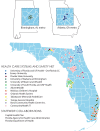The OneFlorida Data Trust: a centralized, translational research data infrastructure of statewide scope
- PMID: 34664656
- PMCID: PMC8922180
- DOI: 10.1093/jamia/ocab221
The OneFlorida Data Trust: a centralized, translational research data infrastructure of statewide scope
Abstract
The OneFlorida Data Trust is a centralized research patient data repository created and managed by the OneFlorida Clinical Research Consortium ("OneFlorida"). It comprises structured electronic health record (EHR), administrative claims, tumor registry, death, and other data on 17.2 million individuals who received healthcare in Florida between January 2012 and the present. Ten healthcare systems in Miami, Orlando, Tampa, Jacksonville, Tallahassee, Gainesville, and rural areas of Florida contribute EHR data, covering the major metropolitan regions in Florida. Deduplication of patients is accomplished via privacy-preserving entity resolution (precision 0.97-0.99, recall 0.75), thereby linking patients' EHR, claims, and death data. Another unique feature is the establishment of mother-baby relationships via Florida vital statistics data. Research usage has been significant, including major studies launched in the National Patient-Centered Clinical Research Network ("PCORnet"), where OneFlorida is 1 of 9 clinical research networks. The Data Trust's robust, centralized, statewide data are a valuable and relatively unique research resource.
Keywords: Clinical Data Research Network; data analysis; data management; data quality; data warehouse.
© The Author(s) 2021. Published by Oxford University Press on behalf of the American Medical Informatics Association.
Figures



References
-
- Sherman RE, Anderson SA, Dal Pan GJ, et al.Real-world evidence—what is it and what can it tell us? N Engl J Med 2016; 375 (23): 2293–7. - PubMed

